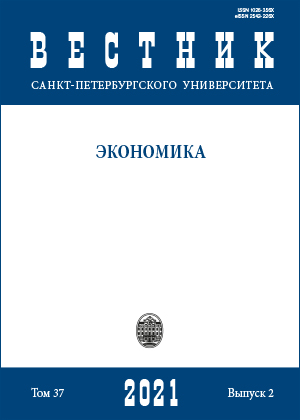Applying Bayesian methods for macroeconomic modeling of business cycle phases
DOI:
https://doi.org/10.21638/spbu05.2021.205Abstract
In the present research, the features of applying two models for estimating macroeconomic dynamic in the USA are investigated: Bayesian vector autoregression and Bayesian vector autoregression with Markov switching. The research goal is to identify periods, structure of fluctuations and the main directions of interaction of the variables (real US GDP and employment) using Bayesian vector autoregression models. Models with Markov chains include many equations (structures). The switching mechanisms between these structures are controlled by an unobservable variable that follows a first-order Markov process. The analyzed variables were taken from the first quarter of 1953 to the third quarter of 2015. The model parameters were estimated on the basis of a prior for the multivariate normal distribution — the inverse Wishart distribution (a generalization of the Minnesota a priori distribution). Basing on the results of the estimation of the two-dimensional model with Markov Switching the average GDP growth rate and expected duration of phases was calculated. The estimated model is acceptable for describing the US economy and with high accuracy describes the probability of being in a particular phase in different periods of time. On the basis of medium-term forecasts, root mean squared errors of the forecast are calculated and a conclusion is made about the most appropriate model. Within the framework of this paper, impulse response functions are built allowing to evaluate how variables in the model react on fluctuations, shocks.
Keywords:
Markov models, Bayesian estimation, business cycles
Downloads
References
Albert J., Chib S. (1993) Bayes Inference via Gibbs Sampling of Autoregressive Time Series Subject to Markov Mean and Variance Shifts. Journal of Business & Economic Statistics, vol. 11, no. 1, pp. 1–15.
Bańbura M., Giannone D., Lenza M. (2014) Conditional forecasts and scenario analysis with vector autoregressions for large cross-sections. ECARES working paper, no. 15.
Bognanni M., Herbst E. (2014) Estimating (Markov-Switching) VAR Models Without Gibbs Sampling: A Sequential Monte Carlo Approach. FRB of Cleveland Working Paper, vol. 14–27.
Chib S. (1995) Marginal likelihood from the Gibbs output. Journal of the American Statistical Association, vol. 90, no. 432, pp. 1313–1321.
Cosslett S. R., Lee L. F. (1985) Serial correlation in latent discrete variable models. Journal of Econometrics,vol. 27, no. 1, pp. 79–97.
Doan T., Litterman R., Sims C. (1984) Forecasting and Conditional Projection Using Realistic Prior Distributions. Econometric Reviews, vol. 3, no. 1, pp. 1 100.
Francq C., Zakoïan J. M. (2001) Stationarity of Multivariate Markov-Switching ARMA Models. Journal of Econometrics, vol. 102, pp. 339–364.
Fruhwirth-Schnatter S. (2001) Markov Chain Monte Carlo Estimation of Classical and Dynamic Switching and Mixture Models. Journal of the American Statistical Association, vol. 96, no. 153, pp. 194–209.
Fruhwirth-Schnatter S. (2008) Finite Mixture and Markov Switching Models. Springer Series in Statistics.511 p.
Hamilton J. (1989) A New Approach to the Economic Analysis of Nonstationary Time Series and the Business Cycle. Econometrica, vol. 57, no. 2, pp. 357 384.
Hamilton J. (2005) What’s real about the business cycle? Federal Reserve Bank of St. Louis Review, vol. 87, pp. 435–452.
Hamilton J. (2016) Macroeconomic Regimes and Regime Shifts. NBER Working Papers, vol. 21863.
Hsu S. H., Kuan C. M. (2001) Identifying Taiwan’s business cycles in 1990s: An application of the bivariate Markov switching model and Gibbs sampling. Journal of Social Sciences and Philosophy, vol. 13,pp. 515–540. (In Chinese)
Hubrich K., Tetlow R. J. (2012) Financial Stress and Economic Dynamics: The Transmission of Crises. FEDS Working Paper, vol. 82.
Karlsson S. (2013) Forecasting with Bayesian Vector Autoregressions. Handbook of economic forecasting. Elsevier. 897 p.
Kim C. J., Nelson C. R. (1999) State-Space Models with Regime Switching: Classical and Gibbs-Sampling Approaches with Applications. MIT Press. 250 p.
Krolzig H. (1997) Markov-switching vector autoregressions: Modelling, statistical inference, and application to business cycle analysis. Springer. 371 p.
Litterman R. B. (1986) Forecasting with Bayesian vector autoregressions 5 years of experience. Journal of Business and Economic Statistics, vol. 4, pp. 25 38.
Orcutt G. A. (1948) Study of the autoregressive nature of the time series used for Tinbergen’s model of the economic system of the United States 1919 1932. Journal of the Royal Statistical Society Series, vol. 10,pp. 1–45.
Sargent T. J., Sims C. A. (2011) Empirical Macroeconomics. Nobel Prize in Economics documents, vol. 2. Stockholm: The Royal Swedish Academy of Sciences.
Schumacher C. (2007) Forecasting German GDP using alternative factor models based on large datasets.Journal of forecasting, vol. 26, no. 4, pp. 271–302.
Sims C. (1980) Macroeconomics and Reality. Econometrica, vol. 48, no. 1, pp. 1–48.
Sims C., Zha T. (1998) Bayesian methods for dynamic multivariate models. International Economic Review,vol. 39, no. 4, pp. 949–968.
Sims C., Zha T. (2006) Were there regimes shifts in U. S. monetary policy? American Economic Review,vol. 96, pp. 54–81.
Sims C., Waggoner D., Zha T. (2008) Methods for inference in large multiple-equation Markov-switching models. Journal of Econometrics, vol. 146, no. 2, pp. 255–274.
Stock J. H., Watson M. W. (2016) Factor Models and Structural Vector Autoregressions in Macroeconomics. Handbook of Macroeconomics, vol. 2, pp. 415 525.
Theodoridis K., Zanetti F., Liu P., Mumtaz H. (2017) Changing Macroeconomic Dynamics at the Zero Lower Bound. Economics Series Working Papers, vol. 824.
Tjøstheim D. (1986) Some Doubly Stochastic Time Series Models. Journal of Time Series Analysis, vol. 7,pp. 51–72.
Wold H. (1960) A generalization of causal chain models. Econometrica, vol. 28, pp. 443–463.
Yang M. X. (2000) Some Properties of Vector Autoregressive Processes with Markov Switching Coefficients.Econometric Theory, vol. 16, pp. 23–43.
Downloads
Published
How to Cite
Issue
Section
License
Articles of the St Petersburg University Journal of Economic Studies are open access distributed under the terms of the License Agreement with Saint Petersburg State University, which permits to the authors unrestricted distribution and self-archiving free of charge.







